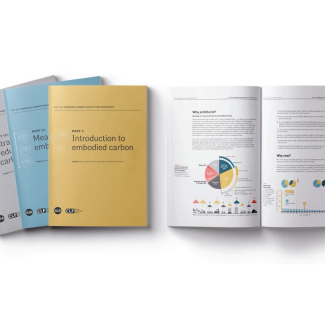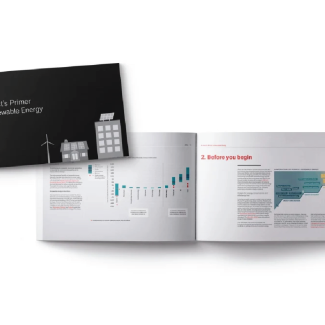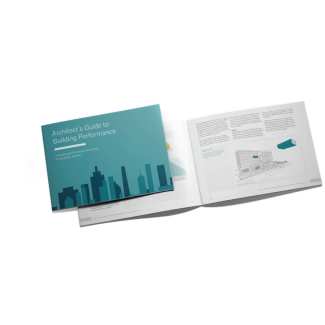Decarbonization & the AIA 2030 Commitment: AIA HQ Approach
The goal of the AIA headquarters renewal is to create an energy-efficient, carbo-neutral building that meets the targets of the AIA 2030 Commitment and fosters an equitable, sustainable, and resilient work environment.

Designing with the AIA 2030 Commitment
Fifteen years ago, Architecture 2030 put forward a clear and ambitious goal for the architecture profession through the 2030 Challenge: Make all buildings carbon-neutral by 2030. AIA’s adoption of this challenge through the formation of the 2030 Commitment, and subsequent adoption by firms large and small, has signaled to the world the intent of this profession to take a leadership role in the global transformation needed to right the ship and keep temperature change below 1.5°C, thereby stemming the worst effects of climate change.
The AIA HQ Renewal is the latest step in matching action with intent. The renewal project will operationalize AIA’s Climate Action Plan with a project that meets the 2030 Commitment target five years ahead of schedule. It will demonstrate a scalable, affordable, and replicable approach to decarbonization in existing buildings.
My firm, EHDD, is currently designing the AIA National Headquarters renovation project in Washington, D.C. I am the Project Director of Sustainability. In my firm’s experience, a focus on electrification with onsite and offsite renewables allows for much simpler mechanical systems at a significantly lower cost than lowering a project's EUI by 80% onsite. This approach recognizes that buildings are an integrated part of the larger energy systems and are interconnected with their broader communities. The AIA HQ Renewal is exhibit A.
Our approach is to push energy efficiency to its cost-effective limit, electrify everything in the building, and then serve the building through a mix of onsite and offsite renewable energy. This effectively brings operational carbon to zero. The embodied (or upfront) carbon associated with building construction and renovation emerges as the thorniest challenge. The big move for the HQ renewal is giving the existing headquarters building new life and avoiding new emissions associated with structure and other building systems.
To further drive down embodied greenhouse gas emissions at every step, key new building elements—from windows to carpet—will be studied via life-cycle assessment to identify the best value options and reduce upfront carbon by an additional 10% to 20%. The remaining embodied emissions will be offset through an innovative local project, such as a renewable energy installation or heat pump retrofit for a public or community-based organization, that will enhance the health and economics of the local community while directly paying down the AIA HQ carbon debt to achieve true carbon neutrality.
The project comes at a time when the 2030 Commitment is at a major inflection point, and it serves to demonstrate a compelling path forward to carbon neutrality. The program’s premise from inception has been to pair deep energy efficiency with onsite renewable energy production as a pathway to achieving full carbon neutrality by 2030. The core metric has been and continues to be net predicted Energy Use Intensity (EUI). As the target has progressively increased to 80% reduction compared to the baseline, many of the nearly 1,000 signatory design firms nationwide have been frustrated by the problem of diminishing returns on efficiency. Until 2020, the program measured compliance through a relatively simple equation of EUI minus onsite renewable energy production, otherwise known as the net-zero energy equation. But achieving ultra-high levels of efficiency can be expensive, and many projects cannot support a large photovoltaic (PV) array.
But a funny thing happened on the way to this future. Renewable energy penetration in the electricity grid has far exceeded even the most optimistic forecasts, and electric building technologies, especially heat pumps, have taken giant leaps in performance and scalability. We are suddenly in a different world, where building electrification combined with a good amount of energy efficiency—though not much more than the most ambitious state codes such as California, Massachusetts, Washington, and New York—can radically reduce the operational carbon emissions of a given building. Combine that with some onsite PVs or purchase of offsite renewables through a local utility, and you can legitimately start to claim carbon neutrality for your building design.
The current generation of the 2030 Commitment reflects this new reality. In a quiet but significant change, the 2030 online reporting portal allowed a breakdown of energy end uses by fuel source (electricity, gas, etc.), and the inclusion of a range of offsite renewable energy procurement as an equivalent pathway to onsite renewable energy. The result is effectively a shift from measuring EUI to measuring fossil fuel consumption. This update builds on the release by Architecture 2030 of the Zero Code, which “integrates cost-effective energy efficiency standards with onsite and/or offsite renewable
energy resulting in Zero-Net-Carbon (ZNC) buildings” and is being adopted as a stretch code by forward-leaning municipalities. AIA's Climate Action Plan calls for a similar approach, stating, "Move buildings to clean-sourced all-electric, incorporating building integrated renewable energy." The Zero Code defines in detail the attributes required for the offsite renewable energy to ensure it is legitimate, including a legally binding contract guaranteed over 15 years, and located in the local electric grid.
Our hope is that the AIA HQ approach can illustrate and broadcast the shift in the 2030 Commitment to the profession at large. We need to restore faith in signatories to achieve the targets and effectively combat climate change in the timeframe needed, with a scalable approach that is cost achievable for our clients.



